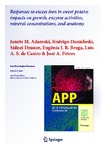Por favor, use este identificador para citar o enlazar este ítem:
http://www.alice.cnptia.embrapa.br/alice/handle/doc/950801Registro completo de metadatos
| Campo DC | Valor | Lengua/Idioma |
|---|---|---|
| dc.contributor.author | ADAMSKI, J. M. | pt_BR |
| dc.contributor.author | DANIELOSKI, R. | pt_BR |
| dc.contributor.author | DEUNER, S. | pt_BR |
| dc.contributor.author | BRAGA, E. J. B. | pt_BR |
| dc.contributor.author | CASTRO, L. A. S. de | pt_BR |
| dc.contributor.author | PETERS, J. A. | pt_BR |
| dc.date.accessioned | 2013-02-25T11:11:11Z | pt_BR |
| dc.date.available | 2013-02-25T11:11:11Z | pt_BR |
| dc.date.created | 2013-02-25 | pt_BR |
| dc.date.issued | 2012 | pt_BR |
| dc.identifier.citation | Acta Physiologiae Plantarum, v. 34, n. 5, p. 1827-1836, September 2012. | pt_BR |
| dc.identifier.issn | 0137-5881 | pt_BR |
| dc.identifier.uri | http://www.alice.cnptia.embrapa.br/alice/handle/doc/950801 | pt_BR |
| dc.description | This study aimed to evaluate the effects of different iron concentrations on growth characteristics, antioxidant enzyme activities, nutrient absorption, and anatomical changes in sweet potato (Ipomoea batatas L.). To accomplish this, seedlings from apical branches of plants that had already been established in the greenhouse were rooted in a hydroponic sponge and then transplanted into a hydroponic system intermittently for 2 weeks and irrigated with nutrient solutions containing iron (ferric-EDTA) at concentrations of 0.45, 0.9, 4.5, and 9.0 mmol L?1. Height, leaf area, and total biomass were significantly reduced at iron concentrations of 4.5 and 9.0 mmol L?1. The iron concentrations in the established leaves and those that developed after the solution supplementation increased significantly. The amounts of other nutrients were also affected, with manganese showing the most significant decrease. The activities of the antioxidant enzymes, superoxide dismutase, and ascorbate peroxidase increased in plants grown in the 9.0 mmol L?1 iron solution. At this concentration, however, the stomatal densities were reduced on the abaxial surfaces of the leaves, although the stomatal diameters increased. The ultrastructures of the radical cells showed mitochondrial impairment at high iron concentrations; however, the chloroplast structures remained unaffected. | pt_BR |
| dc.language.iso | por | pt_BR |
| dc.rights | openAccess | pt_BR |
| dc.subject | Nutrientes | pt_BR |
| dc.subject | Estresse | pt_BR |
| dc.subject | Ferric-EDTA | pt_BR |
| dc.subject | Ipomoea batatas L | pt_BR |
| dc.title | Responses to excess iron in sweet potato: impacts on growth, enzyme activities, mineral concentrations, and anatomy. | pt_BR |
| dc.type | Artigo de periódico | pt_BR |
| dc.date.updated | 2013-02-25T11:11:11Z | pt_BR |
| dc.subject.thesagro | Batata | pt_BR |
| dc.subject.thesagro | Biomassa | pt_BR |
| dc.subject.thesagro | Ferro | pt_BR |
| dc.subject.nalthesaurus | stomata | pt_BR |
| riaa.ainfo.id | 950801 | pt_BR |
| riaa.ainfo.lastupdate | 2013-02-25 | pt_BR |
| dc.identifier.doi | 10.1007/s11738-012-0981-3 | pt_BR |
| dc.contributor.institution | JANETE M. ADAMSKI; RODRIGO DANIELOSKI; SIDNEI DEUNER, CPAC; EUGENIA J. B. BRAGA; LUIS ANTONIO SUITA DE CASTRO, CPACT; JOSE A. PETERS. | pt_BR |
| Aparece en las colecciones: | Artigo em periódico indexado (CPACT)  | |
Ficheros en este ítem:
| Fichero | Descripción | Tamaño | Formato | |
|---|---|---|---|---|
| 12ArtigoPetersCienciasAgrariasA2.pdf | 1.2 MB | Adobe PDF |  Visualizar/Abrir |









